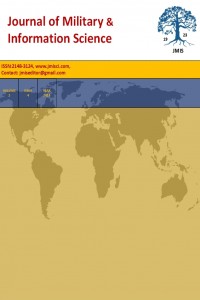Öz
The evaluation of warfare is mostly characterized by technological improvements that affect the ways soldiers get to the desired end state on the battlefield. Cyberspace and space are other imminent dimensions changing the conduct of war. So how must leaders adapt themselves to these changes in the battlefield? What kind of features have gained importance in order to lead and to survive in these techno-wars? The aim of this article is to answer the above mentioned questions. First, how leadership is affected by battlefield and technological improvements is analyzed. Then the features which future leaders must have and how they must behave are discussed. This paper seeks to show major effects of technology and modern warfare on leaders’ physical capabilities, cognitive abilities and emotional stamina.
Anahtar Kelimeler
Leadership Military Leadership Adaption Adaptive Leadership “Soldier-Asker”
Kaynakça
- Army, A. (2013). The Future Land Warfare Report 2013. Australian Army.
- Army, U. (2010). Capstone Concept for Joint Operations: Joint Forces 2020. US Army.
- Army, U. (2013). US Army Leader Development Strategy 2013. US Army.
- Bartone, P. T., & Snook, S. A. (2002). Cognitive and Personality Predictors of Leader Performance in West Point Cadets. Military Psychology, 321-338.
- Bennet, W. J. (1993). The Book of Virtues. New York: Simon & Schuster.
- Buchanan, D., & Huczynski, A. (1997). Organizational Behavior. Italy: Prentice-Hall.
- Burns, J. (2003). Transforming Leadership. New York: Grove.
- Defense, U. M. (2012). Joint Operation Concept 2020. US Minister of Defense.
- Frese, M., & Fay, D. (2001). 4. Personal initiative: An active performance concept for work in the 21st century. Research in organizational behavior, 23, 133-187.
- Jr., W. F. (2010). Military Leadership into the 21st Century: Another “Bridge Too Far?” Parameters Winter, p. 137.
- Loughlin, C., & Arnold, K. (2007). Seeking the Best: Leadership Lessons From the Military. Human Resource Management, p. 148.
- Morath, R. A., Leonard, A., & Zaccaro, S. (2011). Military Leadership: An Overview and Introduction to the Special Issue. Military Psychology, p. 453–461.
- Osborn, R. N., & Hunt, J. G. (2007). Leadership and the choice of order: Complexity and hierarchical perspectives near the edge of chaos. The Leadership Quarterly, p. 337.
- Rost, J. (1991). Leadership for the Twenty-First Century. New York: Praeger.
- Sandhurst, T. R. (2012). Developing Leaders A Sandhurst Guide. The Royal Military Academy Sandhurst.
- Shay, J. (2003). Achilles in Vietnam:Combat Trauma and the Undoing of Character. New York: Scribner.
- Weatherby, G. (1999). Leadership vs Management. Management Review, 5.
- Wong, L., Bliese, P., & McGurk, D. (2003). Military Leadership: A Context Military Review. The Leadership Quarterly, 668.
Öz
Kaynakça
- Army, A. (2013). The Future Land Warfare Report 2013. Australian Army.
- Army, U. (2010). Capstone Concept for Joint Operations: Joint Forces 2020. US Army.
- Army, U. (2013). US Army Leader Development Strategy 2013. US Army.
- Bartone, P. T., & Snook, S. A. (2002). Cognitive and Personality Predictors of Leader Performance in West Point Cadets. Military Psychology, 321-338.
- Bennet, W. J. (1993). The Book of Virtues. New York: Simon & Schuster.
- Buchanan, D., & Huczynski, A. (1997). Organizational Behavior. Italy: Prentice-Hall.
- Burns, J. (2003). Transforming Leadership. New York: Grove.
- Defense, U. M. (2012). Joint Operation Concept 2020. US Minister of Defense.
- Frese, M., & Fay, D. (2001). 4. Personal initiative: An active performance concept for work in the 21st century. Research in organizational behavior, 23, 133-187.
- Jr., W. F. (2010). Military Leadership into the 21st Century: Another “Bridge Too Far?” Parameters Winter, p. 137.
- Loughlin, C., & Arnold, K. (2007). Seeking the Best: Leadership Lessons From the Military. Human Resource Management, p. 148.
- Morath, R. A., Leonard, A., & Zaccaro, S. (2011). Military Leadership: An Overview and Introduction to the Special Issue. Military Psychology, p. 453–461.
- Osborn, R. N., & Hunt, J. G. (2007). Leadership and the choice of order: Complexity and hierarchical perspectives near the edge of chaos. The Leadership Quarterly, p. 337.
- Rost, J. (1991). Leadership for the Twenty-First Century. New York: Praeger.
- Sandhurst, T. R. (2012). Developing Leaders A Sandhurst Guide. The Royal Military Academy Sandhurst.
- Shay, J. (2003). Achilles in Vietnam:Combat Trauma and the Undoing of Character. New York: Scribner.
- Weatherby, G. (1999). Leadership vs Management. Management Review, 5.
- Wong, L., Bliese, P., & McGurk, D. (2003). Military Leadership: A Context Military Review. The Leadership Quarterly, 668.
Ayrıntılar
| Birincil Dil | İngilizce |
|---|---|
| Bölüm | Articles |
| Yazarlar | |
| Yayımlanma Tarihi | 29 Kasım 2014 |
| Yayımlandığı Sayı | Yıl 2014 Cilt: 2 Sayı: 4 |


